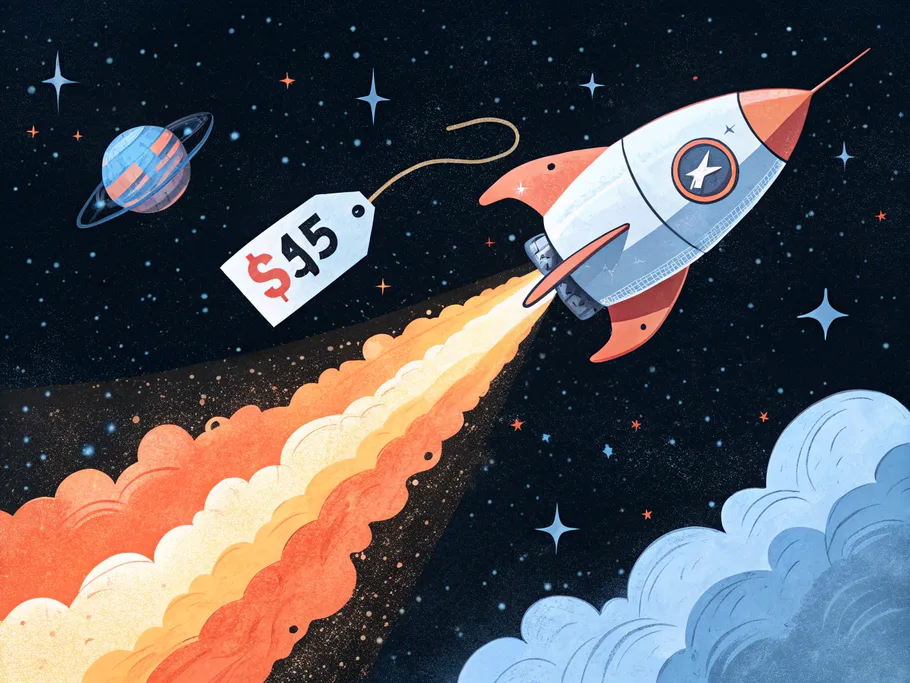Most other articles will bore you with a bunch of tough, icky economic words that make you want to bleach your eyes.
In simpler words…
… business valuation is just figuring out how much a company is worth. It’s like putting a price tag on a business, just like you would for a house or car. It’s that simple.
Slapping on the correct price tag isn’t easy, though. It’s done by looking at how much money the business makes, what it owns (like buildings, equipment, or inventory), and how valuable it is compared to other similar businesses.
Treat this article as an overview, for the love of god. Please consult with a professional if you need to do this.
We are not responsible for any money you lose after reading this. Otherwise, we’d also LOVE to be responsible for the money you make 😀

You might think the reasons for evaluating a business are obvious, but there are more than you’d expect. You may even be surprised. Here they go:
Assets give value to your business. The difference is quite simple, just what you can and cannot touch.
Tangible assets are the physical things a business owns. If you can see it, touch it, or move it, it’s a tangible asset (with a couple of exceptions, as always). You got buildings, land, equipment, vehicles, inventory, products, cash… And stocks, bonds, and debentures, which you can’t really touch.
Intangible assets are the untouchable things that give your business value. I’m talking brand name, reputation, patents, trademarks, copyrights, customer lists, goodwill, software, digital content, methodologies, management approaches, policies, etc.
Your intellectual property can be worth MUCH more than your tangible assets (think Coca-Cola’s brand), but you have to protect them with patents, trademarks, or medieval armor.

As you can imagine, these assets you “can’t touch” are becoming more and more important in business valuations. Digital economy and all that. Just think of Apple and Tesla – they derive significant portions of their value from intangible assets.
Let me explode this thought a little bit.
The production of tangible goods has become overly scaled and cheap. It’s much easier to produce things than it is to sell things.
The market is overcrowded with demand. Suppliers are fighting for the customers’ demand. The world will explode. No, just kidding – but if you think about it, demand means attention.
The customer’s attention is becoming more and more important. Being an attractive brand and getting a sweet spot in the customers’ heads (thus, having an intangible asset) has become SO much more important.
Ever heard of the AIDAL framework?
Since we’re already exploding the topic of assets, let me clarify something.
A business is worth some money only if an asset has been created during the process of building the business that someone wants to buy. If no one wants to buy, then why are we even talking about business valuation?
If you’re not building assets, you’re just self-employed. Your business has no value.
You’ll use a different business valuation method for different purposes. Let me lay them all out neatly and sweetly so you can decide for yourself.
You have three approaches when it comes to selling anything in the world, and also in this case – companies.
The first approach I’ll tell you about is the cost-based approach. Let’s say Amazon wants to buy the Eightception blog (totally hypothetically, but maybe one day).
If Amazon wanted to make the exact same business as mine, it would take them (again, hypothetically) $1M, a year of grinding, an amazing work environment, a really funny personality, etc.
I’d just calculate all my costs and I would add a multiplier to it. The multiplier comes in because – yes, Amazon could recreate the blog themselves with the same money – but it would take them a lot of effort, a year, etc.
This method is mostly used for early-stage startups, just because you don’t have tons of intangible assets, lots of clients, and a big brand yet. The only thing you have is the money you invested and the effort you put in growing the company.
Basically, the buyer comes and asks:
“Hey guys, how much did you invest?” Can you just give us a breakdown? How much did you already spend on building this stuff?”
Years ago, I actually sold a startup with this approach. Okay, the conversation was a bit longer, but you get the gist of it.
The second way to sell is the revenue-based approach. It’s the exact opposite of the cost-based approach because we’re looking at the expected revenue in the future.
It’s also usually used by more mature businesses.
You do this by calculating either your revenue or your profits and you slap a multiplier on top of it.
You slapping that multiplier.
source: https://en.meming.world/wiki/Phil_Swift_Slapping_on_Flex_Tape
If a company is valuated at “ten annual profits”, it means that the buyer who is buying this company will have to wait for ten years to get break even. Only after 10 years will they start to profit.
The question is usually just how big the multiplier is going to be. It mostly depends on the industry and how complex the product is.
In IT, the multipliers are VERY large. In my opinion, too large. If your startups sells anything IT, AI, SaaS related, you’re in for a nice little exit.
On the other side, if you own an advertising agency and you dream of making a big exit… you’re probably not looking at a huge multiplier.
Agencies don’t add a lot of value, they’re usually just middlemen.
With the revenue-based approach, you don’t even have to be profitable to sell! If you recall, that’s how YouTube was acquired by Google. YouTube had a LOT of annual revenue, but they weren’t profitable yet.
Still, Google knew YouTube would bring in a lot of profit in the future, so they bought it.
Both the cost-based approach and the revenue-based approach have “sub-methods”.
Let me show you:
Financial analysts like to look at EBITDA, a revenue-based approach.
EBITDA = net income + depreciation and amortization + interest expense + taxes
Net income is net income, you know that.
Depreciation and amortization refer to “spreading the cost of something over time instead of paying instantly”. Depreciation is for things you can touch and amortization is for things you cannot touch.
Interest expenses are for your debts to debt holders. Taxes are taxes.
EBITDA shows how much money your company can make from its core business before considering costs like debt, taxes, and equipment wear and tear. This makes it useful for comparing companies with different financial setups, tax rules, and accounting methods.
Let’s imagine you’re running a cool startup in a promising tech niche that expects $1M EBITDA in the next 12 months.
We research publicly traded “comparable” startups (as in similar business models, sectors, growth, and profiles). We find those startups generally trade around 8x – 10x EBITDA.
Since we’re nice, we choose a conservative midpoint: 9x.
Super simple formula: Enterprise Value (EV) = EBITDA x Chosen Multiple
In your cool startup case, it’s going to be $1M x 9 = $9M EV.
Also, we have to adjust for net debt and net cash. If your company has more cash then it has debt, it’s going to be worth more. The other way also applies, sadly.
Equity Value = Enterprise Value + Net Cash − Net Debt
So… if, for example, you have $200k of cash and $500k of debt, $9M + 0.2M − $0.5M = $8.7M.
These fictional examples are cool and all… but in the real world – you’ll have to agree on an actual multiplier.
Here are some industry standards you can expect. Clearly, we’re not responsible for these multipliers and the economic situation changes literally every month.
So do your own research. But here are just some numbers you can expect:
| Industry | EV/EBITDA Multiple (avg US March 2025) |
|---|---|
| Technology (SaaS) | 18x |
| Healthcare | 14x |
| Consumer/Retail | 5x-9x |
| Energy (Oil & Gas) | 8x |
| Real Estate | 12x-15x |
| Utilities | 12x |
| Media & Advertising | 11x |
This table is based on the research from these guys: https://fullratio.com/ebitda-multiples-by-industry
After calculating your EBITDA, you and the buyer agree on a multiplier and sign the papers. Profit.
The discounted cash flow or income approach method values a business using the cash inflows and outflows it is expected to generate in the future.
However, you can’t just say “ok 5 years of $1M of expected profit so my startup is worth $5M”. Since the revenue is expected, you have to give a discount.
Basically, you use this method to attract investors. *drooling all over the floor*
Extremely simple example in 3… 2… 1…
A company is expected to generate $1M profit per year during the next 5 years. But the money today is worth more than the future money (inflaaaaation… and also the opportunity to invest the money elsewhere).
So we have to discount the value of the future profits and estimate their current value. The formula is pretty simple and it usually just takes the mid-market key interest rate.
In other words, this method answers: “How much money would I need to invest today (at a certain interest rate) to receive the same $1M per year in the future?”
I’m giving you a brain-break here. This one is extremely easy. The formula goes like this:
Book value of a company = Total assets − Total liabilities
Simply list all of your assets (all 3 of them probably) and subtract all your liabilities.
Let’s say you own $1M in assets and you have $600K in liabilities. That would mean your business is worth $400K. Boom.
This method is good for businesses with tons of tangible assets. However, it doesn’t take into account the intangible ones. So if you own a software company, calculating your worth won’t be this easy.
Sorry.
Liquidation value is the net cash you’ll receive if you wake up one day and decide to liquidate all assets and sell everything.
It operates with a sort of urgency that other methods don’t necessarily consider. You basically say:
“Shut up and give me money! NOW!!!”
Imagine you’re selling a car and you want to sell it for $100,000 (pretty fancy car you got there 😏).
But… It’ll take a reasonable time to find a buyer who would agree on this price. Months even.
At the same time, there’s a buyer standing at your door and saying “I’ll take it right this second for $80k.”
If you urgently need the money, you might take him up on that offer. So, this method usually assumes a reasonable discount and you’ll lose lots of money.
But hey… you’ll get cash really fast!
This is the most subjective one.
It just looks at similar businesses that have sold to determine your business’ worth.
Imagine your business and its assets are worth about $15 million (woah), but similar companies have been recently sold in the $10-million range. You may lose money on the sale if the market value method is used to value your business.
So in that case… well.. don’t use it? Problem solved. That’ll be $1,000 for the financial consultation (just kidding, this is by no means financial advice).
But usually, the market value is the most honest method and it lies in the middle of the cost-based and revenue-based approaches.
With the cost-based approach, the future potential isn’t factored in, so the valuation might be low. In the revenue-based approach, only the future potential is looked at, so the valuation might be too high.
That’s why looking at what similar businesses usually sell for is an honest middle ground.
Also, this is the method you usually end up using. You calculate all the numbers and make all the beautiful hypotheses, but at the end of the day – you often settle for what others would buy your startup for.
We need to get real for a second ‘cause too many founders get this wrong.

The word ‘valuation’ can be very misleading at the startup seed stage.
Some value only arises AFTER an investor decides to invest the first real money into the project.
If 2 years ago, someone purchased 33% of your business for 1M, that’s reliable proof that 2 years ago you were valued at 3M. And if you grew since then, you could say “Hey now we’re worth 5M and here’s the evidence.”
But even that amount of money, honestly, doesn’t reflect any real ‘valuation’ of the project. It just shows the limit of what the investor is willing to lose to see what comes out of it.
Remember: early-stage valuation is more about investor appetite than concrete financials. I still want you to daydream about selling your business and sipping on cocktails in Bora Bora though, okay?
I want you to focus on getting investor money just as much as you focus on selling your product. Don’t just think about the customer acquisition funnel – also think about the investor attraction funnel. Hmm… The ‘investor attraction funnel’ has some charm in it. I like it.
Anyway, what I wanted to say was – product/market fit is not all that matters. You also need to look for risk/yield fit (balance of risk and return).
Here’s a way to see if your company is worth investing in. It’s called “The Rule Of 200” and it works especially well for SaaS companies and startups.
It’s also a great tool to include in your approach to financial planning for entrepreneurs, since it gives you a clear metric to guide growth and investor conversations.
Let me show you.
Basically, the sum of the user retention rate over 12 months in % + year-over-year revenue growth in % + gross margin in % + operating margin in % must be greater than 200.
I know it looks messy. Let me break it down:
If the sum of these percentages is greater than 200, investors know that your business is scalable and efficient.
Business valuation has a lot of general principles, but we also talked about some special cases for startups. Here’s a quick recap:

Email subscription is available ONLY TODAY (oh, okay, and tomorrow).
Surely, we respect your inbox! Unsubscription works every day.

We’d love to tailor your experience — which of these best describes you?